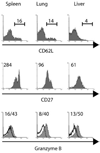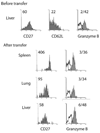Cutting edge: migration to nonlymphoid tissues results in functional conversion of central to effector memory CD8 T cells
- PMID: 17579018
- PMCID: PMC2861291
- DOI: 10.4049/jimmunol.179.1.36
Cutting edge: migration to nonlymphoid tissues results in functional conversion of central to effector memory CD8 T cells
Abstract
Memory CD8 T cells, essential for defense against intracellular pathogens, are heterogeneous with respect to phenotype and function. Constitutively lytic effector memory cells primarily reside in nonlymphoid tissues, whereas secondary lymphoid tissues contain functionally quiescent central memory cells. However, the mechanism by which functionally distinct memory populations are maintained is unknown. In this study, we show that resting CD8 memory cells modified their functional abilities upon entry into nonlymphoid tissues, as exemplified by the induction of granzyme B and lytic activity. Contemporaneously, the costimulator CD27 was down-regulated. These findings hold important implications for memory cell lineage development and tissue-specific immunity.
Conflict of interest statement
The authors have no financial conflict of interest.
Figures




References
-
- Sallusto F, Lenig D, Forster R, Lipp M, Lanzavecchia A. Two subsets of memory T lymphocytes with distinct homing potentials and effector functions. Nature. 1999;401:708–712. - PubMed
-
- Masopust D, Vezys V, Marzo AL, Lefrançois L. Preferential localization of effector memory cells in nonlymphoid tissue. Science. 2001;291:2413–2417. - PubMed
-
- Wherry EJ, Teichgraber V, Becker TC, Masopust D, Kaech SM, Antia R, von Andrian UH, Ahmed R. Lineage relationship and protective immunity of memory CD8 T cell subsets. Nat. Immunol. 2003;4:225–234. - PubMed
Publication types
MeSH terms
Substances
Grants and funding
LinkOut - more resources
Full Text Sources
Other Literature Sources
Research Materials

